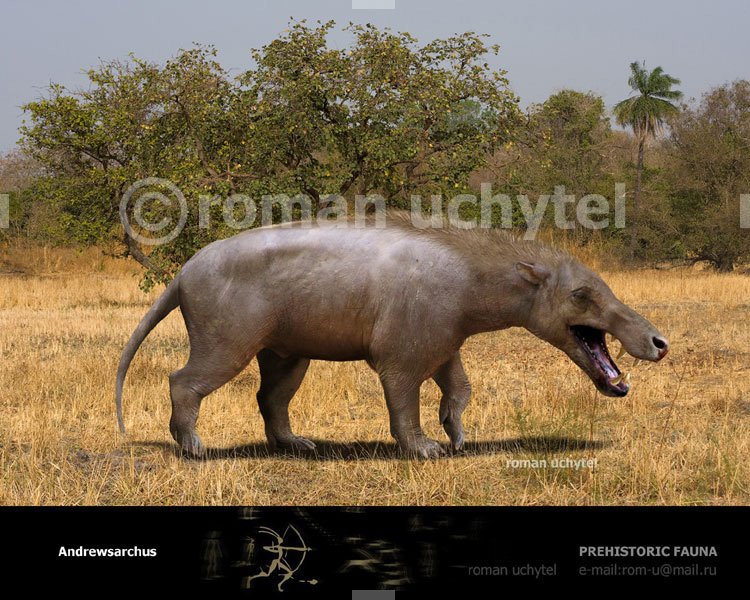Post by dinosauria101 on Mar 14, 2019 9:17:43 GMT 5
Andrewsarchus mongoliensis
Andrewsarchus mongoliensis was a giant mammalian predator of Central Asia and the largest, and most famous member of the mesonychids, a wholly extinct group of prehistoric mammals. The mesonychids were the only known group of ungulates to become carnivorous, and looked vaguely like wolves, with blunt, hoof-like nails instead of claws. Andrewsarchus (Andrews + Greek ἀñ÷üò, "ruler") was named for the famous explorer and fossil hunter Roy Chapman Andrews, who led the expedition on which it was discovered in 1923. Andrewsarchus is known only from an enormous skull (83 cm long and 56 cm wide) and pieces of bone, but the skull's similarity to that of smaller mesonychids suggests that Andrewsarchus had the same wolf-like body on a larger scale. Extrapolating from the body proportions of similar mesonychids, as well as large land mammals in general, Andrewsarchus was most likely about 4–6 metres (13–18 feet) long, standing nearly 2 metres (6 feet) at the shoulder, and weighing well over 1,500 pounds, making it the largest terrestrial carnivorous mammal known to have ever existed. Based on the proportion comparisons to mesonychids and modern day ursids, it is believed that the largest of the Andrewsarchus may have weighed nearly a ton (close to 2,000 pounds, or 907 kg). It is open to debate whether the animal was gracile or robust in build. It should be noted that modern white rhinoceros specimens are much heavier than these figures, though rhino bodies are about as long.

Euoplocephalus tutus
Euoplocephalus (play /juːˌɒplɵˈsɛfələs/ ew-op-lo-sef-ə-ləs; Greek: eu-/ευ- meaning 'well', hoplo-/οπλο- meaning 'armed' and kephale/κεφαλη meaning 'head', "well-armored head") was one of the largest genera of ankylosaurian dinosaurs, at about the size of a small elephant. It is also the ankylosaurian with the best fossil record, so its extensive spiked armor, low-slung body and great club-like tail are well documented. Among the ankylosaurids, Euoplocephalus was exceeded in size only by Tarchia and Ankylosaurus. Euoplocephalus was 6 metres (20 ft) long and weighed about 2.5 tonnes (2.8 short tons). It was also 2.4 metres (7.9 ft) wide. The head and body of Euoplocephalus were covered with bony armor, except for parts of the limbs and possibly the distal tail. Much of this armor was made up of small ossicles. Larger flat scutes, conical plates, and disc-shaped plates were arranged in transverse bands among this pavement of ossicles. Two bands protected the dorsal and lateral surfaces of the neck, four were present across the front part of the torso, three protected the pelvis, and four were present on the anterior half of the tail. The banded arrangement is thought to have permitted some freedom of movement.

Credit to Wikipedia
Andrewsarchus mongoliensis was a giant mammalian predator of Central Asia and the largest, and most famous member of the mesonychids, a wholly extinct group of prehistoric mammals. The mesonychids were the only known group of ungulates to become carnivorous, and looked vaguely like wolves, with blunt, hoof-like nails instead of claws. Andrewsarchus (Andrews + Greek ἀñ÷üò, "ruler") was named for the famous explorer and fossil hunter Roy Chapman Andrews, who led the expedition on which it was discovered in 1923. Andrewsarchus is known only from an enormous skull (83 cm long and 56 cm wide) and pieces of bone, but the skull's similarity to that of smaller mesonychids suggests that Andrewsarchus had the same wolf-like body on a larger scale. Extrapolating from the body proportions of similar mesonychids, as well as large land mammals in general, Andrewsarchus was most likely about 4–6 metres (13–18 feet) long, standing nearly 2 metres (6 feet) at the shoulder, and weighing well over 1,500 pounds, making it the largest terrestrial carnivorous mammal known to have ever existed. Based on the proportion comparisons to mesonychids and modern day ursids, it is believed that the largest of the Andrewsarchus may have weighed nearly a ton (close to 2,000 pounds, or 907 kg). It is open to debate whether the animal was gracile or robust in build. It should be noted that modern white rhinoceros specimens are much heavier than these figures, though rhino bodies are about as long.

Euoplocephalus tutus
Euoplocephalus (play /juːˌɒplɵˈsɛfələs/ ew-op-lo-sef-ə-ləs; Greek: eu-/ευ- meaning 'well', hoplo-/οπλο- meaning 'armed' and kephale/κεφαλη meaning 'head', "well-armored head") was one of the largest genera of ankylosaurian dinosaurs, at about the size of a small elephant. It is also the ankylosaurian with the best fossil record, so its extensive spiked armor, low-slung body and great club-like tail are well documented. Among the ankylosaurids, Euoplocephalus was exceeded in size only by Tarchia and Ankylosaurus. Euoplocephalus was 6 metres (20 ft) long and weighed about 2.5 tonnes (2.8 short tons). It was also 2.4 metres (7.9 ft) wide. The head and body of Euoplocephalus were covered with bony armor, except for parts of the limbs and possibly the distal tail. Much of this armor was made up of small ossicles. Larger flat scutes, conical plates, and disc-shaped plates were arranged in transverse bands among this pavement of ossicles. Two bands protected the dorsal and lateral surfaces of the neck, four were present across the front part of the torso, three protected the pelvis, and four were present on the anterior half of the tail. The banded arrangement is thought to have permitted some freedom of movement.

Credit to Wikipedia



